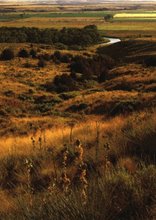
Dispossessing the Wilderness: Indian Removal and the Making of the National Parks. By Mark David Spence (New York: Oxford University Press, 1999). 190 pp. $45.00
In Dispossessing the Wilderness, Mark David Spence states that wilderness preservation went “hand in hand with native dispossession”.[1] Spence’s argument is based on the experiences of a handful of Indian tribes that were dispossessed from certain parts of their traditional homelands by the federal government so that national parks (Yellowstone, Yosemite and Glacier) could be established. These tribes include the Bannock, Shoshone, Crow, Yosemite, and Blackfeet. The thesis of Spence’s book is that “uninhabited wilderness had to be created before it could be preserved”.[2] The reason that these tribes were dispossessed had a great deal to do with changing American perceptions about wilderness, including debates on how to define it and how it should be preserved.
According to Spence, in the first half of the 19th century, conservationists such as George Catlin, Washington Irving, Henry David Thoreau, and John Audubon believed that Indians and wilderness areas should be set aside from the influence of civilization. Spence explains that antebellum America did not conceive of wilderness and Indians as separate, they were fundamentally linked.[3] All of that changed, however, in the years following the Civil War. Spence believes that frontier hostilities between the army and Indian tribes located throughout the Great Plains was one cause for America’s changing perceptions of Indians to the popular belief that they were “evil savages”.[4]
No longer seen as living in harmony with nature, due to the fact that they were impeding America’s manifest destiny, setting fires in forests, and hunting game in areas intended for protection, conservationists of the second half of the 19th century began to reconsider the ideas of earlier conservationists, e.g.: placing Indians in protected wilderness areas. At the same time that Indians were forced off of their traditional homelands onto reservations in order to make the land uninhabited so that it could be preserved, a myth began to circulate that the protected wilderness areas located throughout the West had not been inhabited by Indians for decades. Spence provides evidence linking Indian tribes to each of the three national parks discussed in this book, detailing how that land was used over several centuries and the ways that the various tribes attempted to preserve their treaty rights to practice religious customs and economic tasks in those parks today.
Spence’s work fits into environmental historiography as a complement to works like William Cronon’s essay The Trouble With Wilderness. In reading this book we are again shown that wilderness is a culturally defined term. Wilderness means something entirely different to the tribes discussed in this book then it did for Americans back east. Like the book One Vast Winter Count by Colin G. Calloway, Spence also demonstrates that the idea of a “wild” West before the 19th century is an implausible idea. Many examples are provided in this book to demonstrate that the area we call the West was molded and shaped by Indian tribes for several thousand years before European contact.
[1]
Spence, 3.
[2]
Spence, 4.
[3]
Spence, 10.
[4]
The concept of the “noble savage” and “evil savage” is treated in
Robert F. Berkhofer Jr.The White Man’s Indian: Images of the
American Indian From Columbus to the Present,
Vintage Books, New York, 1979.



No comments:
Post a Comment